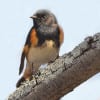 By Jim Stevenson
By Jim Stevenson
1. I have been working very hard on a Gallery that will really show off the Great Plains and it stupendous colorful songbirds. Here are the warblers through longspurs. Mmmmmmm. 2. If there is anyone else who is interested in a five-day trip to the Arizona Mountains in mid-August (not that hot), let me know. Hummers galore! 3. The Great Plains trip ended today, so I will be mailing books tomorrow. Great trip!
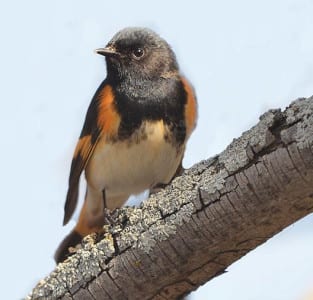
American Redstarts like this male breed over much of North America, with this one in
western North Dakota. There are others in this group from the Desert Southwest to the
Amazon. They spook bugs with the flash colors in their wings and tail and grab them
with their bill. It has bristles at the base to help catch the insect. Can you see these rictal
bristles?
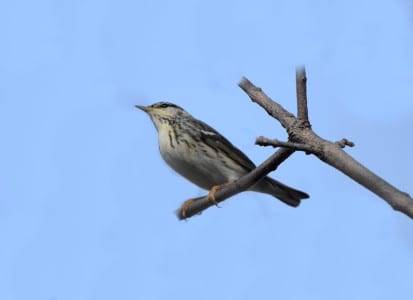
Male Blackpoll Warbler: These birds breed across much of Canada to Alaska, but are
very eastern in their migration (like the next species). They fly SE in the fall and down
the Atlantic Ocean to the West Indies. My friends in Florida will find them very common
in spring, although most fly down the Atlantic Ocean in fall.
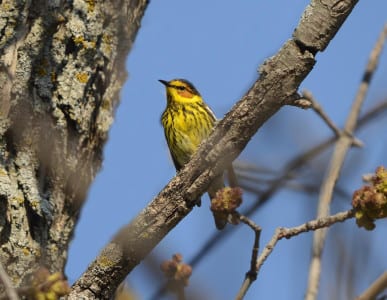
Cape May Warblers are garnet and gold just like the best football team in the Country.
They also breed across Canada and migrate to places around the West Indies. This was a
very big spark bird for me in high school that got me thinking about working on bird
migration in my future. Frankly, it’s never stopped.
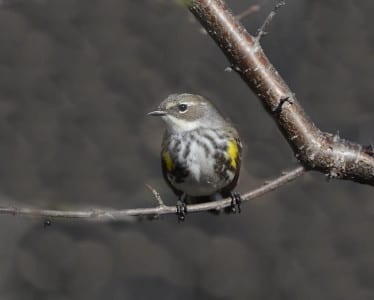
Yellow-rumped Warblers breed across much of North America (not the Deep South) and
are divided into two races. The one in the East (this Myrtle Warbler) has a white throat
and summers all the way to Alaska. The more western Audubon’s Warbler has a yellow
throat and only breeds to Canada. It is a curious thing that usually when there are eastern
and western birds very closely related (like the flickers), it’s the eastern one that reaches
Alaska. Gee, I wonder why!
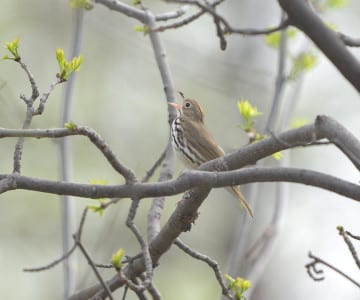
Ovenbirds (and waterthrushes) are largish warblers that are usually seen on or near the
ground. However, to advertize themselves, males often sing from higher, exposed
perches. This lovely Ovenbird is singing about forty miles from the Canadian Border, in
beautiful Theodore Roosevelt National Park.
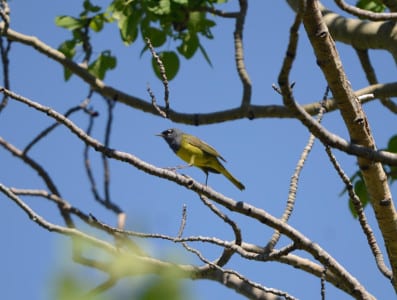
MacGillivray’s Warbler is fair ly common in much of the American West, and its white
eyerings (partial) is reminiscent of the Mourning and Connecticut of the East (although
they will breed fairly far west in Canada). With the broken “eyering,” they really appear
to have white eyelids, an excellent field mark for the few that pass through the UTC.
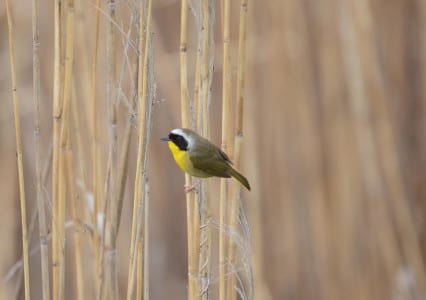
Way out in the arid regions there are small, isolated marshes, and it never fails to produce
the wichita wichita wichita of the singing male Common Yellowthroat. This is a very
widespread and abundant warbler, and spinoff species occur throughout Central America.
Note the black mask, an adaptation found on many groups of animals (like pit vipers) to
hide the conspicuous eye for camouflage.
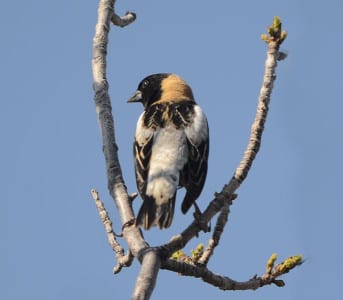
Bobolinks are not closely related to any of our other songbirds, but are grouped with
meadowlarks and blackbirds, etc. They have very strong ruptive markings, breaking up
the form of the bird as they sing from exposed perches. Their migration takes them down
the Atlantic, as their wintering grounds are far to the East. However, once they reach the
US in spring, many fly to western Canada to nest.
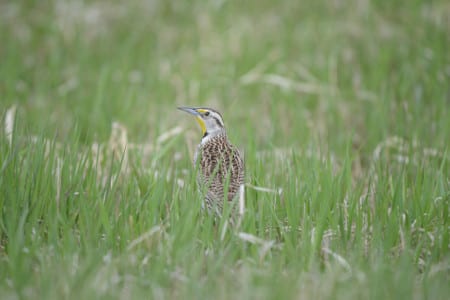
Western Meadowlarks are paler than the eastern counterparts we know from East Texas
to the Atlantic. They do not whistle like Easterns, but rather sing a bit like orioles. Most
male meadowlarks (and many other birds) face away from the road, depriving us of their
rich colors, because most females would be out in the grass.
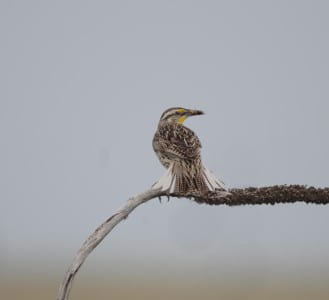
One of the differences between an Eastern and this Western is the amount of white in the
tail. Westerns have 2.5 white tail feathers on each side, as he obeyed my command to
“Spread em!” Also note the dark bars on the tail which are disconnected from each other,
rather than the connected bars on the tail of the Eastern.
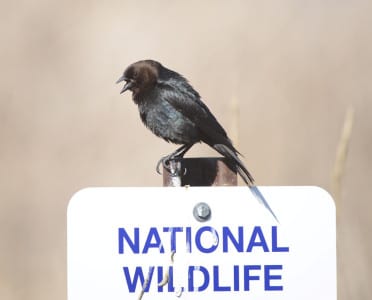
Brown-headed Cowbirds are all over the Great Plains, quite busy dumping their eggs in
unsuspecting birds’ nests. Here you can see the brown head of the male and the conical
bill, p lus the neck ruff reminiscent of Dracula. With modern agr iculture, these birds have
exploded to the point they are a detriment to many songbirds.
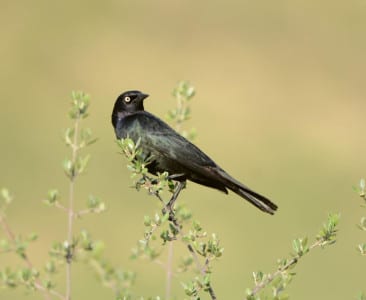
Brewer’s Blackbirds are all over the American West, while the very similar Rusty BB is
disappearing. Brewers seem to like most open habitats, and in winter they range eastward
in open fields and pastures. Both resemble grackles a bit but have a shorter tail, like a
redwing but squared off.
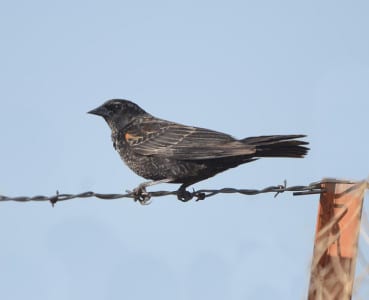
While the vast majority of redwings are currently black with their red epaulets, this one is
lingering in basic plumage. Blackbirds have bills thick enough to crack seeds but thin and
sharp enough for grabbing bugs as well. Redwings have become our most numerous bird
species in the Country, partly on account of agricultural fields in winter.
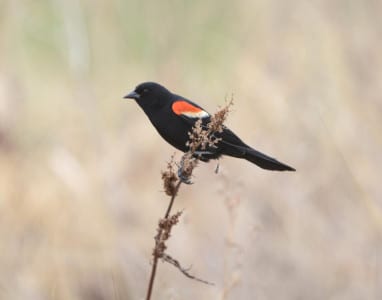
Here is a “full” male on territory, pooping away. They and Yellow-headed Blackbirds
seem to get along f ine, and I honestly don’t know how they are ecologically separated.
However, the Principal of Competitive Exclusion states that no two species can occupy
the same niche at the same time, and I totally believe that’s true.
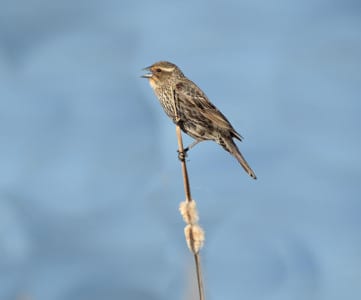
Many people instantly know male redwings but have no idea what the female is. They are
streaked like many sparrows but much larger and often seen in marshes where they nest.
This species is often polygynous, an example of polygamy where the male takes multiple
females. Some phalaropes are examples of polyandry, where one female takes multiple
males. My mind is racing with humorous antidotes about both…
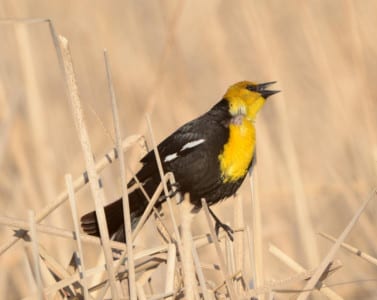
Looking like he was just shot in the neck, this Yellow-headed Blackbird is issuing his
jackass-like call from his cattail territory. These are very common in the NW quarter of
the Country, occasionally wandering eastward with fall cold fronts. The yellow head
gives them the curious scientific name of Xanthocephalus xanthocephalus, a bit like the
Department of Redundancy Department.
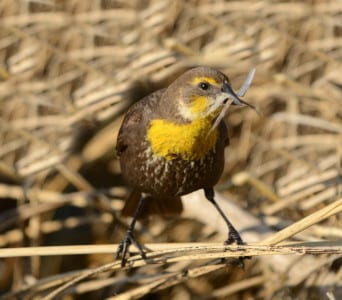
Female xanthocephalus have a modest amount of yellow with a brown body. Birds of
polygynous species have distinct roles, and nest building is reserved for the gals. Males
are therefore stud, running off predators, and their songs cause the ovar ies of the females
to produce ripe eggs. This species really takes to cattail marshes.
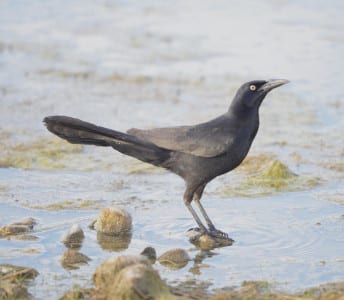
Now, this may LOOK like a Great-tailed Grackle to you, but remember, this is the Great
Salt Lake. And guess what, it is! They have been moving north and west for decades and
this one is where I would never have expected it. Remember, white eyes and flat head.
I’m not quite sure why it doesn’t have a longer tail, but it may be a juvie.
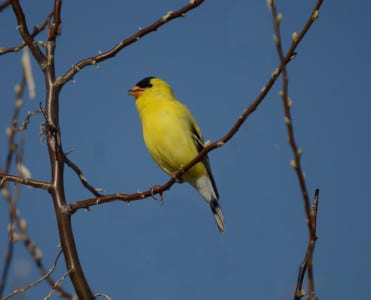
New World finches like this American Goldfinch (male) have squared-off tails. This tiny
species breeds over much of the US, wintering in huge numbers in the Deep South, where
they lose their bright yellow garb in fall. In the past few decades, many northern breeders
don’t range as far south as historically, due to climate change. However, they’re replaced
by more southern species that range northward, evening out the species totals.
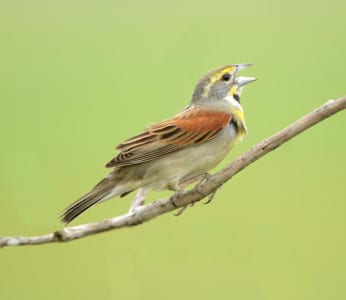
Dickcissels breed in huge numbers in the tall grass prairie, wintering by the millions in
tropical countries such as Venezuela’s Llanos. They appear to distantly resemble a House
Sparrow (use your imagination) but the yellow is common through convergence to the
meadowlarks, Horned Lark, Bokmakierie in Africa and a few other unrelated songbird
members. Why the yellow front with a black bib is selected for so prominently is unclear.
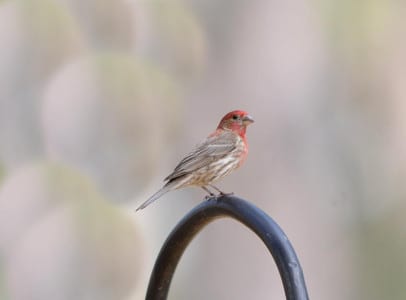
House Finches have spread like wildfire, filling neighborhoods with color. Several other
species resemble them but are either north or west of our area. Males of each are red up
front but females are completely brown streaked. They can be quite a challenge for young
birders to separate, especially out West.
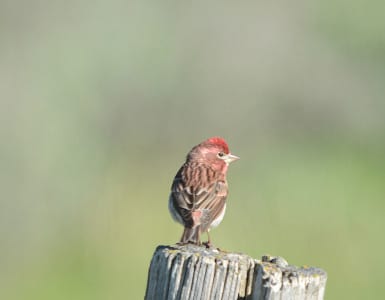
One of the House Finch lookalikes is the Cassin’s Finch, with a more robust head. They
are common from the Yellowstone area to the Pacific, and are even more like the Purple
Finch than House Finches. All these have females with great camouflage to nest-sit, with
some of them singing as if they were males.
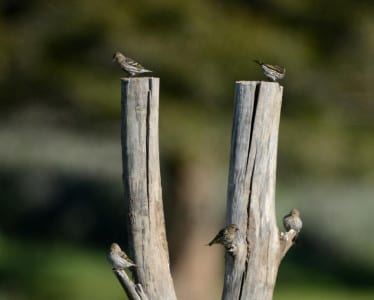
Pine Siskins are abundant breeders in many parts of the West, especially where there are
conifers and/or mountains. They are plain at a distance with streaks but have mighty
yellow patches in their wings that are easily seen overhead. Here you see their abundant
nature, perhaps the only redeeming thing in this picture. :0
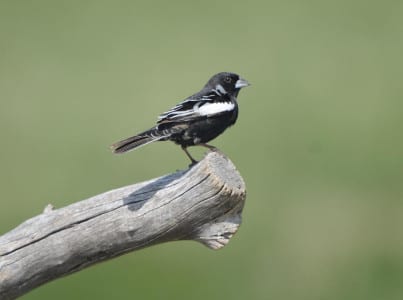
An abundant New World finch in some areas is the Lark Bunting, with males black with
eye-popping white wing-patches. Females are mostly brown but do have the wingpatches
to make ID easier. They nest in shorter grass prairies and migrate south to Mexico early
fall. Then, males resemble females, but they still don’t stop and ask directions.
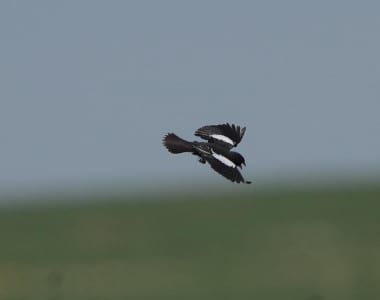
Here’s a Lark Bunting in the air that I managed a halfway decent shot of. Under him are
high plains for many miles in every direction, and above him is blue sky as far as the eye
can see. Welcome to the short grass prairie at 5000 feet. I wish this was a movie so you
cold see their flight style, as much like a bat as any bird.
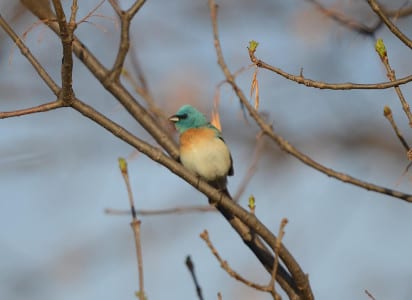
Lazuli Buntings resemble some bluebirds – sorta – but the conical beak gives their ID
away in a glance. Most buntings are also New World in origin (squared-off tails) and
males are brightly colored, for the most part. This species is common over much of the
American West, often seen (or heard) near water courses.
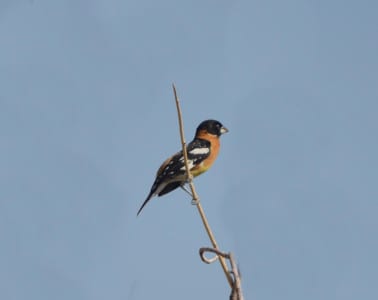
Black-headed Grosbeaks are the grosbeaks of the West, though other species do occur.
They are closely-related to Rose-breasteds of the East, and some hybridizing does occur.
There are many examples of pairs of forest birds split by the Great Plains, although quite
a few eastern species do range well into the West in the north, like in Montana.
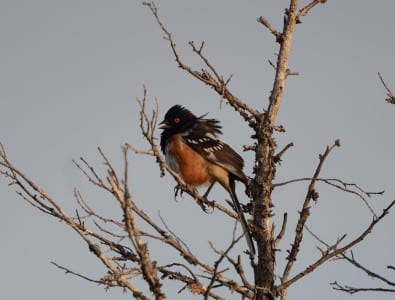
Several species of towhees occur in the West, with this Spotted Towhee being especially
common. They are rather similar to the Eastern Towhee many of you know, like from
Florida. There are several species of unremarkable towhees from the Desert Southwest to
California, a bit like thrashers.
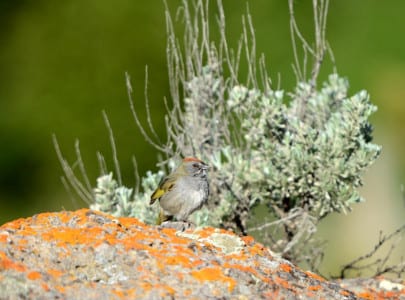
Green-tailed Towhees are the “other” towhee in much of the West. Sandwiched between
orange lichen and a sage, it tells the story of their habitat. They may be heard singing in
rocky canyons throughout much of the West, but are far less conspicuous than Spotted
Towhees. They are also much smaller and remind me a bit of Olive Sparrows.
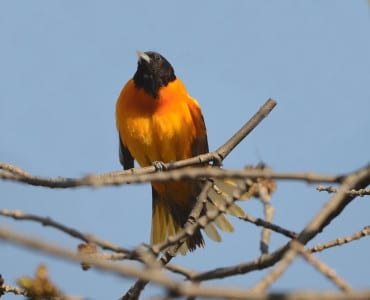
Far out in the Northwest our (eastern?) Baltimore Orioles are found in patches of forest.
They were temporarily lumped with the Bullock’s Oriole of the West, but separated again
as their DNA really wasn’t very close. They do hybridize on occasion but many young
Baltimores fool young birders into believing they have mixed ancestry.
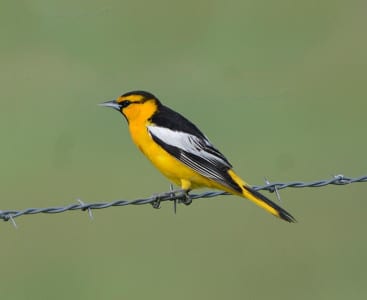
This is the Bullock’s Oriole, found over much of the Amer ican West, and wandering
eastward on occasion in winter. The thin, black lines through the eye and throat are
diagnostic, p lus the large, white wingpatch. There are also other species of more tropical
orioles in the Desert Southwest as well as South Texas.
![Orioles are a lot more nectivorous than many people might think. This male Baltimore was probing flowers on what might be an alder (?) [anyone?], and certainly won’t turn down berries, either. Some bright colors require sugar to maintain, and I have even seen this species robbing sugar water from hummingbird feeders.](https://www.crystalbeachlocalnews.com/wp-content/uploads/2014/06/Advanced-Songbirds33-316x300.jpg)
Orioles are a lot more nectivorous than many people might think. This male Baltimore
was probing flowers on what might be an alder (?) [anyone?], and certainly won’t turn
down berries, either. Some bright colors require sugar to maintain, and I have even seen
this species robbing sugar water from hummingbird feeders.
![Western Tanagers are pretty common out West, occasionally ranging back East to add excitement to the non-breeding season. This one came to a water puddle and sat in a curious posture while our Nikons spoke and the Canon broke. [Sorry, John.] Predators sometimes use drips and feeders to hunt birds, so make sure your facilities are good for the birds, and not a graveyard.](https://www.crystalbeachlocalnews.com/wp-content/uploads/2014/06/Advanced-Songbirds34-397x300.jpg)
Western Tanagers are pretty common out West, occasionally ranging back East to add
excitement to the non-breeding season. This one came to a water puddle and sat in a
curious posture while our Nikons spoke and the Canon broke. [Sorry, John.] Predators
sometimes use drips and feeders to hunt birds, so make sure your facilities are good for
the birds, and not a graveyard.
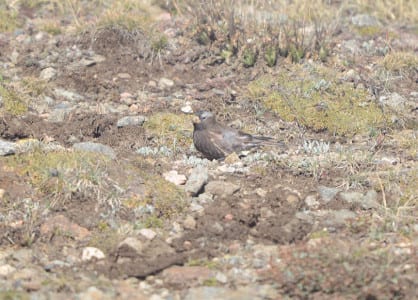
Rosy-finches were once considered one species, but we now recognize three, and perhaps
four separate ones. This is the Black Rosy-finch, shot at 11,000 feet in Beartooth Pass as
we entered Wyoming from Montana on HW 212. They feed on windblown seeds near
snow banks and this year there was a LOT of snow!
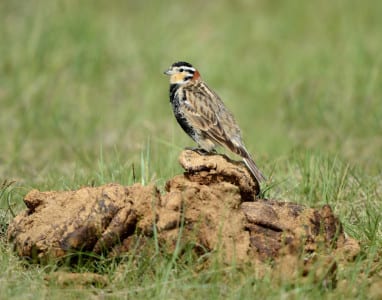
For you advanced birders, this’ll be easy as pie to identify. I won’t tolerate any bull on
this one, and I’ll have a beef with anything except male Chestnut-collared Longspur. OK,
ok. Longspurs are sparrow-relatives but with exceptional color, and this species is quite
common in summer in the northern Great Plains.
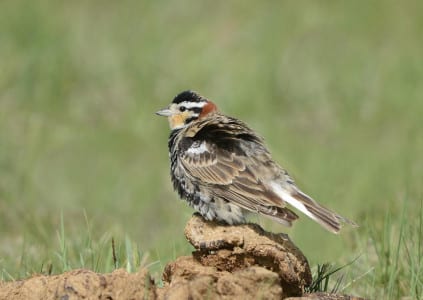
Many birds fluff their feathers to make them lay down properly, and this allows us to
view the telltale white outer-tail feathers in this and the next species. The two longspurs
that nest further north just have white edges on the tail but these have wide designs like
windows. All four winter in the Desert Southwest to the southern Great Plains, but are
not very colorful at that time.
![McCown’s Longspur is the tough member of the group to get, and sure ‘nuff, we only got with 13 feet of this male! Chuckle, chuckle. They have a frosty look with some black on the chest, as males. Females are very tough to separate from CCLS. My best spot for this rare bird is just within a stone’s throw of the Canadian Border, in some of the most beautiful high plains Clint Eastwood ever drifted over. [Now go play C G C G C on your piano.] I sure hope some of you can go on this rather inexpensive trip in the future. ;)](https://www.crystalbeachlocalnews.com/wp-content/uploads/2014/06/Advanced-Songbirds38-383x300.jpg)
McCown’s Longspur is the tough member of the group to get, and sure ‘nuff, we only got
with 13 feet of this male! Chuckle, chuckle. They have a frosty look with some black on
the chest, as males. Females are very tough to separate from CCLS. My best spot for this
rare bird is just within a stone’s throw of the Canadian Border, in some of the most
beautiful high plains Clint Eastwood ever drifted over. [Now go play C G C G C on your
piano.]
I sure hope some of you can go on this rather inexpensive trip in the future.
😉

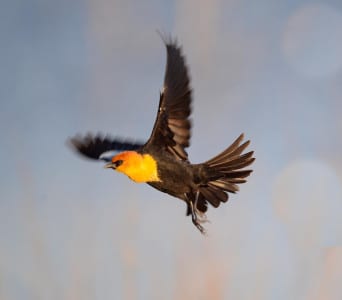
 Posted in
Posted in 























